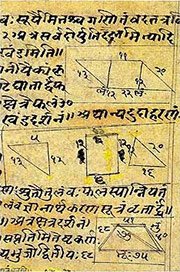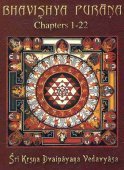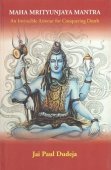Parva: 17 definitions
Introduction:
Parva means something in Hinduism, Sanskrit, Marathi, Hindi, biology. If you want to know the exact meaning, history, etymology or English translation of this term then check out the descriptions on this page. Add your comment or reference to a book if you want to contribute to this summary article.
In Hinduism
Purana and Itihasa (epic history)
Source: Wisdom Library: ItihasaParva means 'episode'. In the Mahabharata they are translated as Books. (the eighteen parva's/books of the Mahabharata).

The Purana (पुराण, purāṇas) refers to Sanskrit literature preserving ancient India’s vast cultural history, including historical legends, religious ceremonies, various arts and sciences. The eighteen mahapuranas total over 400,000 shlokas (metrical couplets) and date to at least several centuries BCE.
Jyotisha (astronomy and astrology)
Source: Wikibooks (hi): Sanskrit Technical TermsParva (पर्व).—1. Time of conjunction or opposition of the Sun and the Moon. 2. Full Moon or the new Moon tithi. 3. An eclipse of the Sun and the Moon. Note: Parva is a Sanskrit technical term used in ancient Indian sciences such as Astronomy, Mathematics and Geometry.

Jyotisha (ज्योतिष, jyotiṣa or jyotish) refers to ‘astronomy’ or “Vedic astrology” and represents the fifth of the six Vedangas (additional sciences to be studied along with the Vedas). Jyotisha concerns itself with the study and prediction of the movements of celestial bodies, in order to calculate the auspicious time for rituals and ceremonies.
Ganitashastra (Mathematics and Algebra)
Source: archive.org: Hindu MathematicsParva (पर्व) represents the number 5 (five) in the “word-numeral system” (bhūtasaṃkhyā), which was used in Sanskrit texts dealing with astronomy, mathematics, metrics, as well as in the dates of inscriptions and manuscripts in ancient Indian literature.—A system of expressing numbers by means of words arranged as in the place-value notation was developed and perfected in India in the early centuries of the Christian era. In this system the numerals [e.g., 5—parva] are expressed by names of things, beings or concepts, which, naturally or in accordance with the teaching of the Śāstras, connote numbers.

Ganitashastra (शिल्पशास्त्र, gaṇitaśāstra) refers to the ancient Indian science of mathematics, algebra, number theory, arithmetic, etc. Closely allied with astronomy, both were commonly taught and studied in universities, even since the 1st millennium BCE. Ganita-shastra also includes ritualistic math-books such as the Shulba-sutras.
Biology (plants and animals)
Source: Google Books: CRC World Dictionary (Regional names)Parva in India is the name of a plant defined with Heteropogon contortus in various botanical sources. This page contains potential references in Ayurveda, modern medicine, and other folk traditions or local practices It has the synonym Andropogon allionii Lam. & DC. (among others).
Example references for further research on medicinal uses or toxicity (see latin names for full list):
· Synopseos Plantarum (1807)
· Bol. Soc. Argent. Bot. (1968)
· Grasses of Ceylon (1956)
· Flora van Nederlandsch Indië (1857)
· Monographiae Phanerogamarum (1889)
· The Flora of British India (1864)
If you are looking for specific details regarding Parva, for example chemical composition, side effects, diet and recipes, extract dosage, health benefits, pregnancy safety, have a look at these references.

This sections includes definitions from the five kingdoms of living things: Animals, Plants, Fungi, Protists and Monera. It will include both the official binomial nomenclature (scientific names usually in Latin) as well as regional spellings and variants.
Languages of India and abroad
Marathi-English dictionary
Source: DDSA: The Molesworth Marathi and English Dictionaryparva (पर्व).—n (S) A common term for particular periods of the year (as the equinoxes, solstices &c.) on which particular ceremonies are commanded, and high degrees of merit are ascribed to obedience; a holy day or festival. 2 A name given to certain days in the lunar month; as the full and change of the moon, and the 6th, 8th, and 10th of each half-month. 3 The moment of the sun's entering a new sign. 4 A conjuncture or juncture; an opportune period. 5 fig. The time or season of any very general practice, of overflowing abundance &c.; the reign, meridian, heyday, zenith, prime, plenitude. 6 A joint or articulation. 7 A division or section of a book, containing several adhyāya or chapters. parva cukaṇēṃ-ṭaḷaṇēṃ &c. To have an opportunity slip from one. parva sādhaṇēṃ-gāṇṭhaṇēṃ &c. To form or to hit an opportunity.
Source: DDSA: The Aryabhusan school dictionary, Marathi-Englishparva (पर्व).—n A holy day or festival. A name given to certain days in the lunar month. The moment of the sun's en- tering a new sign. A conjuncture or juncture. Fig. The time or season of any very general practice, the reign, prime. A joint or articulation. A division or section of a book, con- taining several adhyāya or chapters. parva cukaṇēṃ-ṭaḷaṇēṃ &c. To have an opportunity slip from one. parva sādhaṇē-gāṇṭhaṇēṃ &c. To hit an opportunity.
Marathi is an Indo-European language having over 70 million native speakers people in (predominantly) Maharashtra India. Marathi, like many other Indo-Aryan languages, evolved from early forms of Prakrit, which itself is a subset of Sanskrit, one of the most ancient languages of the world.
Sanskrit dictionary
Source: Cologne Digital Sanskrit Dictionaries: Edgerton Buddhist Hybrid Sanskrit DictionaryParva (पर्व).—see parvan.
Source: Cologne Digital Sanskrit Dictionaries: Shabda-Sagara Sanskrit-English DictionaryPārva (पार्व) or Pārvva.—mfn.
(-rvaḥ-rvī-rvaṃ) Relating to a Parva, a particular day of the month, &c. E. parvan, and aṇ aff.
Source: Cologne Digital Sanskrit Dictionaries: Benfey Sanskrit-English DictionaryParva (पर्व).—[-parva], a substitute for parvan as latter part of a comp. adj., f. vā, e. g. karkaśa-, One whose (fingers') joints are hard. tri-, Having three knots.
Source: Cologne Digital Sanskrit Dictionaries: Cappeller Sanskrit-English DictionaryParva (पर्व).—(adj. —°) = parvan.
Source: Cologne Digital Sanskrit Dictionaries: Monier-Williams Sanskrit-English DictionaryParva (पर्व):—[from parv] in [compound] for van.
Source: Cologne Digital Sanskrit Dictionaries: Yates Sanskrit-English Dictionary1) Parva (पर्व):—parvati 1. a. To go or move.
2) parvati 1. a. To fill.
3) Pārva (पार्व):—[(rvva-rvvā-rvvaṃ) a.] Of a feast day.
Source: DDSA: Paia-sadda-mahannavo; a comprehensive Prakrit Hindi dictionary (S)Parvā (पर्वा) in the Sanskrit language is related to the Prakrit word: Pavvā.
[Sanskrit to German]
Sanskrit, also spelled संस्कृतम् (saṃskṛtam), is an ancient language of India commonly seen as the grandmother of the Indo-European language family (even English!). Closely allied with Prakrit and Pali, Sanskrit is more exhaustive in both grammar and terms and has the most extensive collection of literature in the world, greatly surpassing its sister-languages Greek and Latin.
Hindi dictionary
Source: DDSA: A practical Hindi-English dictionary1) Parva in Hindi refers in English to:—(nf) see [paravaha]; the first day of each lunar fortnight..—parva (परवा) is alternatively transliterated as Paravā.
2) Parva (पर्व) [Also spelled parv]:—(nm) festival; festal day; a day or occasion for performance of religious rites; a chapter; -[kāla] festal day/occasion.
...
Kannada-English dictionary
Source: Alar: Kannada-English corpusParva (ಪರ್ವ):—
1) [noun] the act of joining, associating, bringing two or more things together; association.
2) [noun] the hard joint of the stem of a plant (as of jowar, sugarcane, bamboo, etc.); a node.
3) [noun] a place or part where two bones or corresponding structures are joined, so that they can move; a joint.
4) [noun] any of the main divisions of a book; a chapter.
5) [noun] any of the days of conjunctions, as full moon-day, new moon-day, the days of solstices, etc.
6) [noun] an oblation, offering made on these festival days.
7) [noun] a part or division of a whole.
8) [noun] a time or day of feasting or celebration; a festival day.
9) [noun] (fig.) joy; delight.
--- OR ---
Parvā (ಪರ್ವಾ):—
1) [noun] anxious concern in a person or a thing that belongs to others.
2) [noun] thoughtful consideration; careful attention.
3) [noun] connection or manner of being connected or related; connection.
--- OR ---
Pārva (ಪಾರ್ವ):—[noun] = ಪಾರುವ [paruva].
Kannada is a Dravidian language (as opposed to the Indo-European language family) mainly spoken in the southwestern region of India.
See also (Relevant definitions)
Starts with (+211): Parivalli, Parva-bida, Parva-mas-otsava, Parvabhaga, Parvabheda, Parvadakshina, Parvadevata, Parvadhi, Parvadivasa, Parvagamin, Parvagup, Parvagupta, Parvah, Parvahan-beemaa, Parvai, Parvaiccattam, Parvaiccillu, Parvaiman, Parvaipar, Parvaittakatu.
Ends with (+119): Abhimanyuvadhaparva, Abhutaparva, Adiparva, Agraparva, Ajagaraparva, Alauparva, Anudyutaparva, Anugitaparva, Anukramanikaparva, Anushasanaparva, Anushasanikaparva, Apaddharmaparva, Araneyaparva, Aranyaparva, Arghabhihanaparva, Arjunabhigamanaparva, Arjunavanavasaparva, Ashramavasaparva, Ashramavasikaparva, Ashvamedhaparva.
Full-text (+3834): Shataparva, Parvan, Parvatayana, Parvva, Parvam, Parvani, Parvagamin, Ashramavasikaparva, Rohitparva, Parvanadi, Yavana, Sahasraparva, Astikaparva, Ashramavasaparva, Prayoga, Alambusha, Anvadhanakriya, Parv, Parvavadin, Suparva.
Relevant text
Search found 96 books and stories containing Parva, Pārva, Parvā; (plurals include: Parvas, Pārvas, Parvās). You can also click to the full overview containing English textual excerpts. Below are direct links for the most relevant articles:
Samkhya thoughts in the Mahabharata (by Shini M.V.)
Introduction to the Mahābhārata < [Chapter 1 - Introduction]
Sāṃkhya philosophy in the Śānti-parva and (Introduction) < [Chapter 4 - Sāṃkhya thoughts in the Śānti-parva of Mahābhārata]
Works on Sāṃkhya < [Chapter 2 - The Principles of Sāṃkhya Philosophy]
Puranic encyclopaedia (by Vettam Mani)
Varahi Tantra (English Study) (by Roberta Pamio)
Chapter 20 - Various explanations of the Krama system < [Summary of the Vārāhī Tantra]
List of Mahabharata tribes (by Laxman Burdak)
Manusmriti with the Commentary of Medhatithi (by Ganganatha Jha)
Verse 4.128 < [Section XIV - Other Duties]
Verse 4.10 < [Section II - Means of Subsistence]
Verse 4.153-155 < [Section XIV - Other Duties]
Mahabharata (English) (by Kisari Mohan Ganguli)
Section 6 < [Svargarohanika Parva]
Section II < [Sangraha Parva]
Related products


